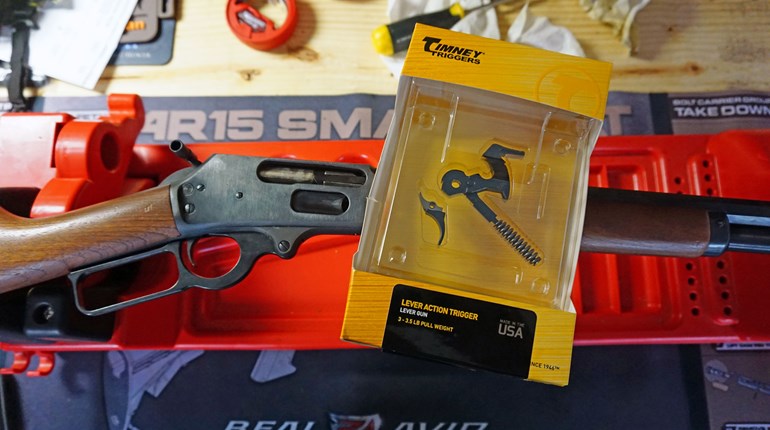
A year from now, we are all going to be fed up with polls, polling places and pollsters. Heck, most of us are already sick of them, and yet the relentless onslaught of wannabe kingmakers will continue unabated for at least another 12 months. These days, I seek refuge from election “polls” by focusing instead on trigger “pulls.” We talk and write much about the value of good triggers in our rifles, but seldom do we quantify the difference between a crummy trigger and a good one. Instead we just accept that a “match” trigger will be better than what the factory offered and generally appreciate the crisper, lighter feel of any new trigger.
Freefloating barrels is usually step number one on rifles I accurize, and getting triggers right is step number two. Depending on the type of rifle, I either install a good-quality aftermarket trigger or hone and adjust the factory unit. When possible, I do pre- and post-modification testing, which gives me a real appreciation for improved triggers. However, in nearly every case other work is also performed, so I cannot quantify the effect of the trigger work alone. Last summer I decided to do a simple before-and-after test of a rifle with a pretty terrible factory trigger—the Mosin-Nagant M44 carbine.
I chose an aftermarket drop-in trigger from Timney for this project, just to see how much difference a light, clean break would make. It’s about as much fun to listen to a politician’s robo-call as it is to test this rifle’s accuracy—both feature elements of agony, but only shooting the Mosin has a tangible purpose.
The original trigger in this nearly 125-year-old design came to me with a pull weight of approximately 6.5 pounds. Pull weight was inconsistent (varying by a half pound in either direction), exceedingly long and, like all Mosin-Nagant stock triggers, the closer it got to releasing the firing pin the heavier the pull stacked up. I have tried to shoot both this carbine and a longer Model 1891 as slowly and accurately as possible in order to ascertain their out-of-the-box accuracy levels. The best I can manage—as depicted in the table below—is about what you would expect on a rifle designed for mass production, very little training and a conscript army.
The Mosin-Nagant stock is probably awesome for firing while running forward in a human-wave assault. But for precision work, it lacks just about everything needed. So to mitigate the stock’s effect on range results, I used a bench-mounted Caldwell Lead Sled for my group shooting. OK, I used the Lead Sled because the Mosin is a shoulder killer. Or maybe I am just a wuss. I also used the somewhat crude, factory iron sights, but only because I did not plan ahead well enough to have a scope mount in time for testing.
My comparison was simple: fire four groups with the unaltered factory trigger and the same number after installing the Timney, then measure the results. Installing the Timney on the action used up all of two minutes, most of which involved taking the action out of the stock. That was the easy part. Fitting the new trigger housing within the tight confines of the old factory stock used up another hour’s worth of careful Dremel, sandpaper and chisel work. The finished product has an easily adjustable, single-stage trigger with a functional manual safety to boot and a pull weight set at 2.5 pounds.
It is plain to see that this simple modification made a big difference in my ability to shoot the M44 accurately. The light carbine is still a long way from being a precision instrument, but any improvement is better than none. Fixing the rifle’s crummy ergonomics is another topic.
Using a Mosin-Nagant as my example here may be a bit extreme, but I have seen the same positive results from much simpler trigger replacements. I have installed several dozen ALG Defense ACT and QMS triggers over the years, replacing all sorts of heavy, creepy factory AR triggers. The ALGs are designed to meet all Mil-Spec safety and reliability requirements, but are engineered and manufactured to clean up the creepy pull and gritty break for which stock AR triggers are notorious. I have shot some of my best groups from ARs with those combat-ready, non-match triggers, thanks to cleaner, more-repeatable pull weights.
Another option is the JP Enterprises reduced-power spring kit for target, hunting or competition ARs that replaces factory trigger springs. It will not eliminate the stock trigger gritty feel, but it will significantly reduce creep and pull weight on a rifle’s trigger. These springs do wear out faster than normal, and JP Enterprises does not recommend using them for fighting rifles.
Dropping in a replacement trigger is a simple and cost-effective way to improve the shooter-rifle interface. How big is this market? Take a look at just a small sampling of the aftermarket triggers available. Timney’s Featherweight adjustable two-stage triggers are available for a wide range of budget-priced, surplus rifles in the $86 to $108 range from Brownells. That is almost the cost of the Mosin-Nagant, but cheaper options abound for other rifles. ALG Defense’s AR and AK triggers run from $45 to $65 from Brownells and other sources, making them incredibly good values as compared to match options. The JP Enterprises spring kits mentioned earlier run just $11. Geissele offers the Super Sabra trigger for the IWI US Tavor bullpup rifle among its offerings of upgraded triggers. There are many other good triggers, too, and their values cannot be overstated when it comes to good rifle shooting that hunters, competitors, plinkers and home defenders can all appreciate.




































